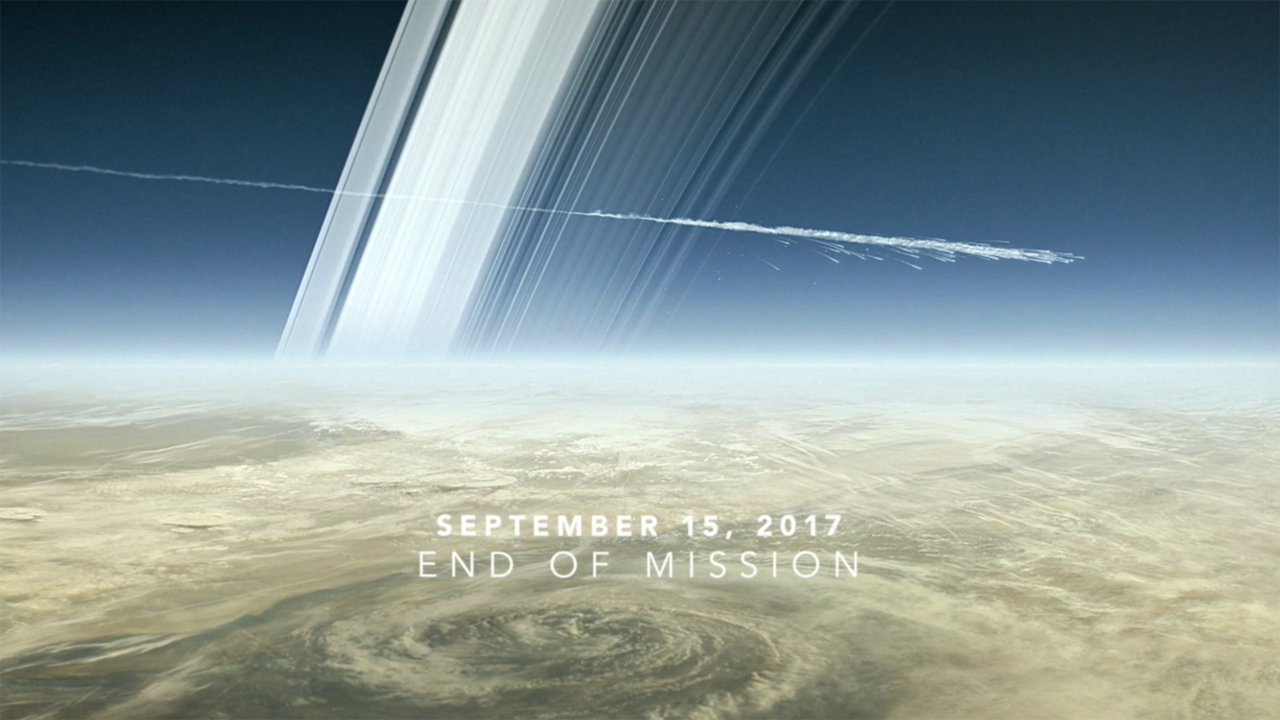CASSINI: The Grand Finale
Saturn Tour: Where is Cassini Now?
Latest Updates
The final signal will take 83 minutes to reach Earth.
Sept. 15, 2017 (5:45 a.m. PDT): Cassini has completed its mission at Saturn. As predicted, the spacecraft lost contact with Earth at 4:55 a.m. PDT (7:55 a.m. EDT).
Sept. 15, 2017 (3:31 a.m. PDT): Cassini is scheduled to begin its entry into Saturn’s atmosphere soon, with a confirming signal received on Earth at 4:55 a.m. PDT (7:55 a.m. EDT). Engineers anticipate loss of contact about one minute later.
Sept. 15, 2017 (1:55 a.m. PDT): Cassini engineers have received the signal that Cassini has started a five-minute roll to point the instrument that will sample Saturn’s atmosphere (INMS) into the optimal direction, facing the direction of the oncoming gases. Along with this roll, the spacecraft is reconfiguring its systems for real-time data transmission at a rate of 27 kilobits per second (3.4 kilobytes per second). Final, real-time relay of data starts immediately after. That relay marks the beginning of Cassini’s final plunge.
Sept. 14, 2017 (4:45 p.m. PDT): Cassini has begun transmitting data — including the final images taken by its imaging cameras — in advance of its final plunge into Saturn on Sept. 15. The spacecraft is in the process of emptying its onboard solid-state recorder of all science data, prior to reconfiguring for a near-real-time data relay during the final plunge. Unprocessed (or “raw” images) are available here. The communications link with the spacecraft is continuous from now through the end of mission (about 12 hours).
Sept. 14, 2017 (1 p.m. PDT): Cassini’s imaging cameras were scheduled to take their final image of the mission at 12:58 p.m. PDT (3:58 p.m. EDT) today. The final image was an observation of the location where the spacecraft is expected to enter Saturn’s atmosphere on Friday, Sept. 15. The primary instrument observing the impact site was the visual and infrared mapping spectrometer (VIMS), with the imaging cameras riding along in a supporting observation. The impact location at this time was on the planet’s night side, lit by reflected light from the rings.
Sept. 13, 2017 (2:15 p.m. PDT): Cassini is on final approach to Saturn, following confirmation by mission navigators that it is on course to dive into the planet’s atmosphere on Sept. 15. The mission’s final calculations predict a signal will be received on Earth indicating loss of contact with the Cassini spacecraft on Sept. 15 is 4:55 a.m. PDT (7:55 a.m. EDT). More details
Sept. 12, 2017 (9:45 p.m. PDT): Cassini is back in contact with Earth following its distant flyby of Titan, and data are streaming in. As planned, ground controllers made contact with the spacecraft at 6:19 p.m. PDT.
Sept. 11, 2017 (10:30 p.m. PDT): Cassini reached apoapse—the farthest point from Saturn in its orbit—for the last time in its 13-year mission. Apoapse occurred at a distance of 800,000 miles (1.3 million kilometers) from Saturn at approximately 10:27 p.m. PDT (1:27 a.m. on Sept. 12 EDT. From this point, the spacecraft is headed toward Saturn.
Sept. 11, 2017 (2 p.m. PDT): Cassini has successfully made its closest approach to Titan in a distant flyby that will cause the robotic spacecraft to plunge into Saturn on Sept. 15. The spacecraft flew to within 73,974 miles (119,049 kilometers) of the moon’s surface at 12:04 p.m. PDT (3:04 p.m. EDT). If all goes as expected, Cassini will make contact with Earth on Sept. 12 at about 6:19 p.m. PDT (9:19 p.m. EDT). Images and other science data taken during the encounter are expected to begin streaming to Earth soon after. Navigators will analyze the spacecraft’s trajectory following this downlink to confirm that Cassini is precisely on course to dive into Saturn at the planned time, location and altitude.
Sept. 11, 2017 (9 a.m. PDT): Cassini completed its final dive through the gap between Saturn and the rings on Sept. 9 at 5:09 p.m. PDT (8:09 p.m. EDT). Closest approach to Saturn was 1,044 miles (1,680 kilometers) above the cloud tops. The spacecraft is now headed for its final, distant flyby of Titan, which will provide a gravitational nudge that will push the spacecraft into Saturn on Sept. 15.
___
http://saturn.jpl.nasa.gov/mission/saturn-tour/where-is-cassini-now/
